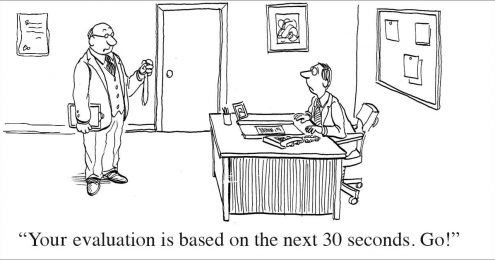We all know this person. Let’s call him Jeff.
At a glance, Jeff appears to be a high performing staff member. Yes, his ego is out the wazoo (what exactly is a “wazoo?”). But he cares about his department and his own success. Jeff is super smart, maybe the smartest person in the room.
But also… Jeff is not a team player. He gets away with behavior that is intolerable by any standards because he delivers. And he does deliver. But Jeff also seems to enjoy crushing his co-workers like bugs.
So riddle me this…
Is Jeff a high performer? Without a formal and effective performance review process, how would he know? I bet he thinks he is a high performer. But truly, he is probably more trouble than he’s worth.
Maybe your nonprofit already does a performance review for each and every staff member. If so, great! But maybe you think they’re not super effective and could be handled better.
Or maybe you’re just not doing them at all for whatever reason.
Either way, I have some critical tips on how to give a performance review the right way.
PERFORMANCE REVIEWS… DO I HAVE TO???
One of the fourteen attributes of a thriving nonprofit is “regular performance reviews and assessments for both staff and board.”
So obviously I think formal performance reviews are pretty important. And yet, I know plenty of nonprofit organizations that don’t do them.
I hear plenty of excuses.
“We want to do them but can’t get everyone to agree on the mechanism, the tool.”
“We just don’t have the time.”
“She’s a good employee. We tell her all the time, so why do we need to go through all this?”
“I heard through the grapevine that he is looking for another job, so why bother?”
Enough already!
A performance review for staff at every single level is simply part of being a grownup and thriving organization. Period.
I know, I know. Performance reviews can seem like busy work. Your mission is to save the world, not to make the staff feel good.
But here’s the thing. You often waste way more time by not doing performance reviews.
Imagine you have to fire someone for poor performance and you haven’t done a formal review in years (or ever). Do you know how much time you waste building the case and/or hanging on to that employee well past her ‘expiration date’ because you have to build some kind of performance improvement plan that you know she can’t possibly meet?
WAY BEFORE THE PERFORMANCE REVIEW
How can you do an effective performance review if you haven’t set any goals? If you don’t even know what success looks like for a particular job?
Obviously, it’s an issue if you don’t have these. But don’t use this as an excuse to avoid performance reviews entirely.
You need to develop goals, job descriptions, and success metrics.
But here’s the thing. They don’t have to be so ridiculously detailed that it takes forever. And besides, you will wind up in the weeds when you really want to focus on the trees (consider the organization’s annual goals to be the forest.)
ATTRIBUTES AND VALUES
Remember Jeff? The employee who’s something of a jerk but always delivers?
I asked if he’s a high performer.
I say no. Not if his organization has put a stake in the ground about the attributes of success and what it values in its employees and the organizational culture.
But without a performance review – without setting clear goals and expectations – Jeff’s organization is being unfair to Jeff. After all, no one can ever assume the criteria on which they are being evaluated. It has to be spelled out.
And if you focus only on WHAT Jeff does and the evaluation does not include HOW Jeff does what he does, you will have no ability to hold Jeff accountable for all his bug crushing.
THE KEY TO A SUCCESSFUL PERFORMANCE REVIEW PROCESS
I’m going to assume that you are the Executive Director or the head of your school. If you are the Head of School, this is a process that should kick off at the start of a school year so adjust the timing accordingly.
I’m also going to assume that you are not a large enough organization to have a Director of HR, though perhaps you have a more junior level staffer who posts positions and screens.
Step 1: The New Year’s Eve Bucket List
Set aside 2-3 hours before Jan 15. No Internet, no meetings, no interruptions.
Draft a set of 7-10 organizational goals for the year, what I like to call “The New Year’s Eve Bucket List.” When the year ends, what do you want to say your organization accomplished?
The bucket list should be drafted in such a way that you can’t wiggle into “yes” even though the answer was “probably not.”
Rather than re-invent the wheel, I found a good primer on goals vs. strategies vs. objectives vs. tactics. If you need that, have a read here.
Then I want you to write down 5-10 attributes you value in the folks you work with. Could be attributes like “work ethic” or “accepts constructive feedback” or (to use a basketball metaphor) “understands the values of ‘assists’ and not just scoring.”
Step 2: The Staff Meeting
Set an extended staff meeting by mid January. Include either the full staff or (if large) just your direct reports. The meeting will need to be a good solid two hours. I’d prefer three. Feed people. That makes them happy.
There will be only two agenda items:
- Share the draft goals and ask for their observations, insights, and thoughts. Edit and finalize. As the E.D. the final call is yours – make that clear.
- Share your draft attributes. Again, ask for observations and insights. The call again is yours. And be sure that every staff member knows that these attributes will be part of an annual performance review.
Step 3: Staff Homework
Give each staff member homework. You will give them three tasks:
- Review your current job description or draft one if none exists.
- Develop a list of goals for yourself that tie into and drive the success of the organizational goals.
- Include some goals about HOW you will be working during the year in the spirit of the discussed attributes.
Step 4: Set Goals
Meet with each staffer before the end of January and reviews the drafts in Step 3. It’s a conversation that results in a list of goals both parties are comfortable with. They should be neither slam dunks nor totally out of reach. This conversation should be set for 90 minutes and it should include healthy back and forth.
BUT WHAT ABOUT THE EVALUATION FORM?
I promise to get to that in a future post. This one is getting long.
But here’s what I am learning. Precious few organizations engage in any thoughtful discussion about what success looks like for staff members, both in terms of outcome and behavior. And if you don’t set those before or at the start of the year, then a performance review process is meaningless because you have no basis for evaluation.
So this is where you need to start. Set some basic organizational goals, share, discuss and finalize. Then define people’s roles and what success looks like for them this year. Only then can you create a performance review template and process. So stay tuned.
Think about all this kinda like New Year’s resolutions. Except these matter to every client, community member, stakeholder, colleague, and donor in the sector.
You might not lose those extra 10 pounds this year or read 10 good books. But these resolutions? So much is riding on them.
ONE LAST THING – IT’S IMPORTANT
If I was a donor to your organization and was so generous that my gift equated to the salary of a your poor performing CEO or your poor performing development manager, could you look me in the eye and tell me that my money is being invested well in the pursuit of the mission I believe in with all my heart?
If you can’t, the answer to all of this is quite simple.
You owe it to each and every donor and each and every client or community member to make your very best effort to have the right folks, the best folks, the most diverse folks on your field – doing the very best work they can do.
And the only way to do that is to set goals and hold folks accountable to them.
It all seems so obvious to me. But so many organizations struggle with this from the CEO down.
Tell me what I am missing. Comment below and tell me what’s in your way. I will do my level best to try to offer my best thinking about how to remove the obstacles.




Can you apply this for board members too or is this just for staff?
Similar question: can this apply to performance eval *FOR* the ED? We currently have a form which I don’t care for.
Really love the big, bucket list goals & associated attributes approach to this. Nice way to bring alignment–and I have the advantage of laying the recently minted strategic plan alongside to create close alignment, with enough detail for staff to spin work plans off of the big list & strategic plan! BTW, HATE our forms for reviews (at least most of them), so looking forward to your wisdom on forms, too! Thanks!
+1 I have the similar question, as I would like to improve our performance eval and criteria for our ED as we have begun to evolve the business strategy.
I review my staff on going…and they never need to dread a performance review because they always know how they’re doing.
My “formal” review is actually an opportunity for each one to discuss what she thinks and how she’s doing and share that with me. We discuss their goals, areas which they believe they need to improve or have a better opportunity to stretch. I simply listen, give input and talk about the future. It’s a friendly, bonding experience.
Lisa. I would like to work for you! I believe deeply that an annual review should include zero surprises. Joan
Jeff. I need to get started on those forms. Have gotten lots of subscriber emails this morning echoing this sentiment! And you are VERY welcome.
Nurse Ellen: ABSOLUTELY. ED will be a more complex eval forms because of the number of areas of responsibility but goal setting as noted above, YOU BET
Ask your ED for org and goals by department (including her or his own). Make that part of your first or second board meetings of the year. AND create a committee to develop BOARD GOALS TOO!!!!!
AJW. Yes! Especially important for committees. Each committee should have a clear charge and using that, set up its “big goals’ for 2017. When you know what success looks like, you are more invested. And thus you are more likely to come to committee meetings and DO THINGS!!!!
I totally agree so we address any problems or issues as they arise, not at the performance review, which in my opinion, should be positive and a lengthy opportunity for discussion.
Lisa
Thank you. Love your blog! Learning so much. We are very, very new! Cheers! Adrienne,
Thank you Joan! I love your blog and I am learning so much from it. Please advise when a sample form for ED evaluation might be available….as I said, our current one is, shall we say, “lacking”, and eval time is around the corner. Happy New Year!
Once everyone has filled out their reviews WHO IS supposed to compile the results and give the report? Can one person collect the evaluations and report? what is the legal protocol for this?
🙂
Joan I have only just found you and am already impressed.
My thoughts:
Good managers value performance reviews and see them as setting their staff up for success.
Every employee has the right to know what is expected of them!
Every manager has the right to inspect the employee against those expectations!
And only when the manager has done these consistently are they a good manager. See I believe there is no such thing as ‘naughty employees’, they are the product of bad managers (just like no such thing as naughty children, they are the result of bad parenting). Really good managers meet with their direct reports in a semi formal way at least each month and if that is done the annual performance review should be more like a ‘coaching looking forward discussion’ and should have no surprises.
P.s. this is no different for a not for profit or for profit
Thank you Joan, we have done a good job on changing the culture the last 2 years to have documented goals from Staff through to the board. My next task is to improve the evaluation of the ED, so there is good clarity between him and the board. Something that has been lacking. I look forward to seeing a ED performance Evaluation template. Thank you for the blog and time you spend helping the non-profit community.
Joan, have you created theses forms? I was trying to find them but wasn’t having any luck. I would love to see what you came up with.